Yokohama Museum of Art Collection September 21, 2019 – January 13, 2020
Aspects of Japan’s 160-year Relationship with the West
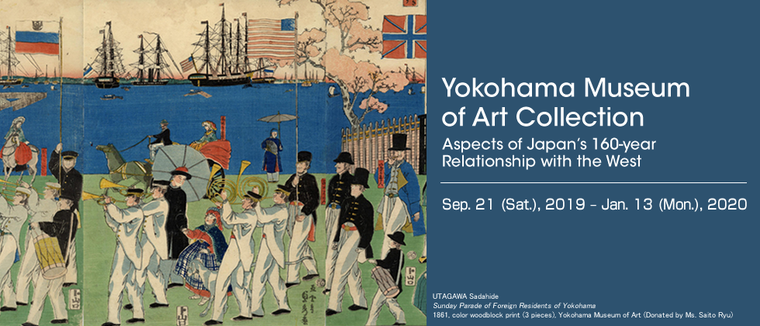
UTAGAWA Sadahide
"Sunday Parade of Foreign Residents of Yokohama"(detail)
1861, color woodblock print (3 pieces), donated by Ms. Saito Ryu
Overview
Prologue: "Pacific―Shattered Blue"
Ⅰ. The Paris of Fujita Tsuguharu and Hasegawa Kiyoshi
Ⅱ. German Modernism and Japan
Ⅲ. The Japanese Experience in Multiethnic America
Ⅳ. Okada Kenzo’s Yugen-ism
Ⅴ. Art Informel and Gutai
Ⅵ. Neo-Dada
Ⅶ. Yokohama Ukiyo-e and Exported Crafts
Ⅷ. Shimomura Kanzan’s Experiences in Europe
Ⅸ. The Japan of Woodblock Prints
Ⅹ. Meiji Photography and Japanese Landscapes
Special Feature
Potters in Yokohama: Miyagawa Kozan I and Inoue Ryosai III
Isamu Noguchi and Sculptures in the 20th Century
LIST OF WORKS [1,288KB]
In this edition of the collection exhibition, overlapping with the anniversaries of the Yokohama Museum of Art and the opening of Yokohama Port, we reexamine the relationship between Japan and the West, which serves as one of the central pillars for Yokohama’s collection of artworks. Many exhibitions dealing with the opening of Yokohama Port focus on the reception and development of Western-style expressions in the late Edo (1603-1867) and Meiji Periods (1868-1912) or the activities of painters, printmakers, and photographers who came to Japan during this era. However, in this exhibition, which is not restricted to any one age, we concentrate on several topics related to the way in which different cultures resonated with each other during the lengthy period that stretched from the opening of Yokohama Port in 1859 to the post-World War II era.
In post-World War I Paris, a period that corresponds to closely to the works now on view in the "Masterpieces from the Musée de l’Orangerie, Jean Walter and Paul Guillaume Collection" exhibition, artists such as Fujita Tsuguharu and Hasegawa Kiyoshi were pioneering their own forms of creative expression. Another figure of the day was Natori Yonosuke, who launched the propaganda magazine "Nippon" after absorbing and enacting new theories of German design, including those of Bauhaus. Traces of Japanese and nikkei (Japanese immigrant) artists’ work can also be found in the U.S., which faced with a certain amount of conflict in regard to the country’s multiethnic society.
After World War II, a period which saw a sudden acceleration in transport services and information media, there was an emergence of art movements that shared a common awareness while exerting a mutual influence. This is exemplified by the relationships between Art Informel in France and Gutai in Japan, and the American Neo-Dada movement and the Japanese Neo Dadaism Organizers. Another keyword here is woodblock prints, as seen in the display of works by Paul Jacoulet, a Japan-based painter who embraced the ukiyo-e tradition, and Yoshida Hiroshi, who strategically targeted foreign audiences with an up-to-date version of Japanese prints. Tucked in between these various topics, you will find several other displays, such as “Yokohama Ukiyo-e” and “Meiji Photography,” which include many new acquisitions. Rather than a single full-length offering, this exhibition is made of a number of shorter parts, so please relax and enjoy your visit as you stroll through the galleries.
After leaving the collection exhibition, please make your way downstairs to Art Gallery 1, where "Following the Path of Commodore Perry’s Arrival through Images" will be on view through November 10. This exhibition focuses on depictions of historical events, centering on the work "Commodore Perry Coming Ashore at Yokohama."
The exchange between Eastern and Western culture that began in 1859 has borne a diverse range of fruit. These two exhibitions, drawn from the Yokohama Museum of Art collection, provide an opportunity to reconsider the opening of Yokohama Port as the start of a fertile and vibrant history that continues to this day.
Prologue: “Pacific―Shattered Blue”
The map, printed on a piece of muslin, is an enlarged version of a map that was included as an insert in the book “The Theory of Japanese Colonization” (1891). Due to the map’s “upside-down” orientation, the Japanese archipelago is located in the lower right, and an arc stretches from Yokohama Port to South and North America, Australia, the South Sea Islands, and China. Attached to the top of the map, seemingly auguring Japan’s impending militarism, are shards of glass bearing underwater photographs of cargo vessels and fighter planes that were lost in the Pacific War, and the battleship “Nagato,” which was sunk in a nuclear test conducted at Bikini Atoll in 1946. The title “Shattered Blue” suggests that the sea has been smashed into thousands of small pieces. By superimposing remnants of the Showa era (1926-1989) on a map from the Meiji era (1868-1912), Yanagi Yukinori artfully expresses the accumulation of painful history events related to the Pacific Ocean.
After Japan opened its ports in 1859 and reestablished marine links with the outside world, the country’s policies sometimes involved subjugating other nations. This work, which recalls some of the negative aspects of cultural exchange, serves as the prologue to Japan’s 160-year relationship with the West.
Section 1: The Paris of Fujita Tsuguharu and Hasegawa Kiyoshi
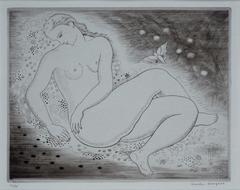
HASEGAWA Kiyoshi
"Dream"
1925, drypoint, 22.0×27.9cm
In response to World War I, which had wrought large-scale destruction and slaughter, the Paris art world of the 1920s entered a period of restoration marked by the use of traditional subject matter and sober approaches. Picasso’s plump nudes can be seen as part of this movement, which was termed a “return to order.” Fujita and Hasegawa’s nudes exemplify the fact that while breathing the air of the times, both artists created vivid works.
1918: World War I ends. The Treaty of Versailles is signed the following years.
1920: The League of Nations is formed, with Japan among the permanent members of the security council. 1926: Emperor Taisho dies on December 25.
Section 2: German Modernism and Japan
This year marks the 100th anniversary of the Bauhaus. Over the course of its short 14-year history, the German art school was located in three different cities: Weimar, Dessau, and Berlin. The teachers and students at the Bauhaus were distinguished by their international mindset, and the school was a fluid educational institution that embraced a variety of cultures. The new visual expressions that emerged from the Bauhaus led to the development of art photography and the flourishing of the experimental photography movement Neue Fotografie, which was headed by László Moholy-Nagy, a teacher at the school. The Bauhaus’ activities and this new approach to photography attracted international interest, including that of Japanese artists who were exploring fresh types of modern expression.
In 1933, following the rise of the Nazis, the Bauhaus was forced to close its doors. Modern art was condemned as labeled “degenerate art.” During the same period in Japan, some of the design and photojournalistic techniques that had been cultivated at the Bauhaus were used to create imperialist propaganda. In this era of global crisis, German and Japanese artists were constantly being questioned about their political attitudes.
1933: The Nazi Party comes to power.
1936: The Berlin Olympics are held.
1938: The Japanese government passes the National General Mobilization Act.
1939: World War II breaks out.
Section 3: The Japanese Experience in Multiethnic America
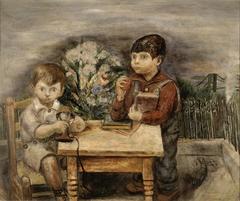
NODA Hideo
"Two Children"
1934, oil on canvas
75.0×90.2cm
Caught between two nations, the artists’ works were constantly beset with anxiety and difficulty. The Great Depression began in 1929 and the situation gradually worsened. With the outbreak of World War II, Japan and America’s relationship grew hostile, leading the U.S. government to enforce an internment policy for people of Japanese ancestry, which made the environment even more tense. These artists pursued unique forms of expression based on the joy of receiving access to art in their new homeland and the hardships they suffered as immigrants.
1858: The Treaty of Amity and Commerce is concluded between Japan and the U.S.
1869: The first group of Japanese immigrants settles in California.
1924: The U.S. government passes the 1924 Immigration Act (often referred to as the Japanese Exclusion Act).
1941: Japanese forces attack Pearl Harbor in Hawaii, leading to the outbreak of the Pacific War.
Section 4: Okada Kenzo’s Yugen-ism
Born in Yokohama in 1902, Okada Kenzo dropped out of Tokyo School of Fine Arts (now Tokyo University of the Arts) and moved to France in search of new artistic expressions. After returning to Japan in 1927, Okada joined the Nika-kai art group. But reaching a deadlock in his work, he left the country again in 1950, this time settling in the U.S. While initially bewildered by the work of Abstract Expressionists like Jackson Pollock and Mark Rothko, who were taking New York by storm, Okada engaged in a series of experiments. This led to his discovery by Betty Parsons, who staged Okada’s first solo show in 1953. This marked the start of an ongoing association with Parsons’ gallery.
American critics acclaimed Okada’s works for his method of integrating Eastern elements with abstract expressions. These included paintings such as “Rain,” composed of slanted lines; “Vertical,” seemingly inspired by the pillars on a noh stage; and “Orange No. 2,” in which planes of color recalling paper cutouts erase the division between figure and ground. Okada used the term “Yugen-ism” (the word “yugen” means “subtle and profound”) to refer to his artistic realm.
1945: World War II ends.
1947: U.S. Secretary of State George Marshall proposes the European Recovery Program (commonly known as the Marshall Plan).
1950: The Korean War breaks out.
1951: The Treaty of San Francisco is concluded.
Section 5: Art Informel and Gutai
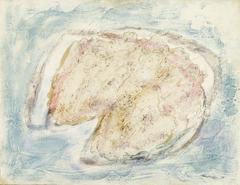
Jean FAUTRIER
"Untitled"
1956, gouache and plaster on paper mounted on canvas
50.0×65.0cm
As Japan made the transition from postwar reconstruction to high economic growth, there was also a rise of avant-garde art. Among the most prominent was the Gutai Art Association, founded in 1954 in order to “concretely express the notion that the spirit is free.” The group’s members included Shiraga Kazuo, who used his feet to smear paint across a canvas stretched out on the floor; Tanaka Atsuko, who staged performances in which she wore a dress of colorful electric light bulbs; and Motonaga Sadamasa, who streamed paint down tilted canvases. The artists’ approaches, conceived as a battle between the body and matter, first reached an international audience following Tapié’s 1957 visit to Japan. It was then that he lauded Gutai as the Japanese wing of the Art Informel movement.
1946: Jean-Paul Sartre publishes “Existentialism Is a Humanism.”
1953: Television broadcasting commences in Japan.
1954: The Algerian War of Independence breaks out.
1956: An economic white paper published by the Japanese Economic Planning Agency declares an end to the post-war period.
Section 6: Neo-Dada
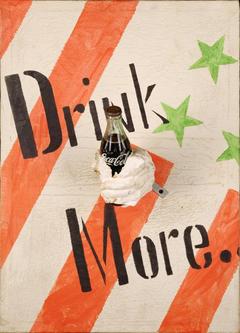
SHINOHARA Ushio
"Lovely Lovely America (Drink More)"
1964, fluorescent paint, lacquer, plaster, metal, Coca-Cola bottle and canvas
64.5×46.7cm
The artists’ works were also introduced in Japan, inspiring a group called the Neo-Dadaism Organizers, which was formed in 1960 by Yoshimura Masunobu, Arakawa Shusaku, and Shinohara Ushio among others. In Shinohara’s “Drink More,” he copied images of the Stars and Stripes and Coca-Cola, which had appeared in Johns and Rauschenberg’s pieces. The work expresses a complex emotion response to American culture, which had not only come to rule the political economy but the world as a whole. It also exemplifies Shinohara’s tenacious spirit as an artist who attempted to reverse these conditions through the power of his art.
1945: The Bretton Woods Agreement is enacted, establishing a fixed exchange rate tethered to the U.S. dollar.
1955: The Montgomery bus boycott is staged in Alabama in response to a call from civil rights activist Rev. Martin Luther King Jr.
1963: U.S. President John F. Kennedy is assassinated in Dallas.
1964: The Tokyo Olympics begin. Coca-Cola Japan is among the event’s sponsors.
Section 7: Yokohama Ukiyo-e and Exported Crafts
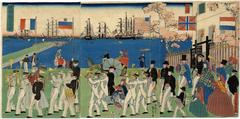
UTAGAWA Sadahide
"Sunday Parade of Foreign Residents of Yokohama"
1861, color woodblock print (3 pieces),
donated by Ms. Saito Ryu
During the same period, Miyagawa Kozan I moved from Kyoto to Yokohama and opened a kiln in order to produce ceramics for export. Miyagawa’s Makuzu ware, distinguished by its delicate and sumptuous high relief, enjoyed popularity all over the world.
While Yokohama ukiyo-e presented novel scenes of the West using the traditional genre of woodblock printing, Makuzu ware made a strong impact on Western aesthetics as the essence of Japanese handwork. The two contrasting media clearly illustrate the reception and dispatch of other cultures during the port-opening period.
1858: After concluding the Treaty of Amity and Commerce with the U.S, the Edo shogunate follows suit with Holland, Russia, England, and France.
1867: Imperial rule is restored, followed the next year with the start of the Meiji era.
1873: The Meiji government takes part in the 1873 Vienna World Exposition.
1877: The First Domestic Industrial Exposition is held in Japan.
Section 8: Shimomura Kanzan’s Experiences in Europe
Shimomura Kanzan was among the first class of students to enroll in Tokyo School of Fine Arts (now Tokyo University of the Arts) in 1889. Such were his abilities that he was hired to teach at the school upon graduation. On February 21, 1903, Shimomura set out for England from Yokohama Port as the first overseas student dispatched by the Ministry of Education. Studying for two years in the U.K. and traveling around Europe for another six months, Shimomura voraciously consumed Western art. He researched watercolor painting (making a copy of John Everett Millais’ “The Knight Errant,” etc.) and used Japanese materials to reproduce Renaissance paintings on silk (including Raphael’s “The Madonna of the Chair” and “Madonna of the Goldfinch”).
In a newspaper interview Shimomura gave before embarking on the trip, he said, “I want to take a close look at things like color. I’ve seen Western paintings in photographs, but you can’t really grasp the colors from a photograph. The thing that I want to look at most overseas is color.” The ornate coloration in Shimomura’s epic work “Mt. Ogura” and the shading of the figure’s face in “Vimala-kirti,” both made after the artist returned to Japan, are proof of the artist’s sense of purpose and the steady progress he made during his stay in Europe.
1900: The Ministry of Agriculture and Commerce publishes “Histoire de l’art du Japon” to coincide with the Paris Expo. (A Japanese edition appears the following year.)
1902: The Anglo-Japanese Alliance is concluded to counter Russian expansion in the Far East.
1904: The Russo-Japanese War breaks out.
1905: Natsume Soseki’s novel “I Am a Cat” begins to be serialized.
Section 9: The Japan of Woodblock Prints
Ukiyo-e artists such as Hokusai and Hiroshige triggered the Japonism movement of the late 19th century, and Japanese woodblock prints continue to capture Western viewers’ interest.
Initially, Paul Jacoulet, who came to Japan from France when he was three, studied Japanese-style painting. In 1933, he established the Jacoulet Woodblock Print Institute. In cooperation with carvers and printers, Jacoulet produced a series of unique woodblock prints, which depicted customs from Japan, the South Seas, Korea, and China in a charming array of colors.
Yamagishi Kazue, one of the period’s leading carvers, was involved in making Jacoulet’s first print and the works that were included in his first print series. After being commissioned by the Ministry of Education to study trends in Western printmaking in 1926, Yamagishi created his own series called “One Hundred Views of the World.”
Yoshida Hiroshi, who repeatedly traveled abroad after first going to the U.S. in 1899, collaborated with American curators to organize a traveling show of Japanese woodblock prints of the period. The large exhibition, consisting of 342 works by ten Shinhanga (“new print”) artists, including Yoshida himself. They were notable for having revived the traditional ukiyo-e division of labor in the Taisho era. The show led the movement to become popular in the U.S.
1923: The Great Kanto Earthquake strikes.
1925: The Maintenance of the Public Order Act is enacted. The General Election Law is passed.
1932: The Japanese government declares the foundation of Manchukuo (Manchuria), installing Puyi as head of state.
1933: Franklin D. Roosevelt is elected president of the U.S. He undertakes the New Deal policy as a means of surmounting the Great Depression.
Section 10: Meiji Photography and Japanese Landscapes
Around the time that Japan reopened to the outside world in the late 19th century, new forms of visual media began to arrive in the country. The English photographer Felice Beato, who arrived in Japan in about 1863, took pictures of landscapes all over the country. At the same time, Charles Wirgman, also from the U.K., made numerous paintings of Japanese scenery and customs. Many other foreign photographers and painters took up residence in Yokohama, popularizing these media and preparing the way for the next generation.
Photography and Western-style painting developed in their own way based on exchanges between foreign and Japanese people. But as suggested by the widespread practice of coloring photographs, these two media had a much closer relationship than they do today. Both photographers and painters followed a similar course, traveling to cities and famous sites throughout Japan and frequently depicting the same places.
In this section, we present various Japanese landscapes depicted with diverse media but based on the use of common places and motifs. Please enjoy making your way through these landscapes of the Meiji era as if you were accompanying the artists on their travels.
1859: Japan reopens to the outside world with the opening of ports in Yokohama, Hakodate, and Nagasaki.
1862: Shimooka Renjo opens a photographic studio in Noge, Yokohama.
1867: Imperial rule is restored.
1872: Japan’s first railway line is constructed between Shimbashi, Tokyo and Yokohama.
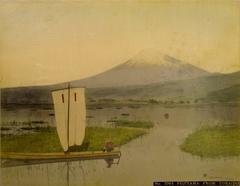
TAMAMURA Kozaburo[presumed]
"Mt. Fuji, fromTokaido"
ca.1880s, hand-colored albumen silver print 19.3×24.9cm, donated by Mr. Kajikawa Norio
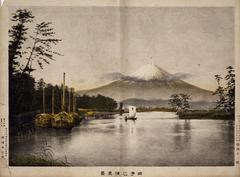
KUMAZAWA Kitaro[painter & printer]
"View of Tagonoura"
1892,
hand-colored lithograph
26.3×37.3cm, donated by Mr. Kojima Yutaka (formerly owned by Kojima Usui)
Outline
| Dates | September 21 (Sat.) - January 13 (Mon), 2020 |
|---|---|
| Open Hours | 10:00-18:00 *10:00-20:00 on Fridays and Saturdays. / 10:00-21:00 on Sep. 27, 28, Jan. 10, 11, 12. *Admission until 30 minutes before closing. |
| Closed | Thursdays (except December. 26), December. 28, 2019 - January. 2, 2020 |
| Organized by | Yokohama Museum of Art[Yokohama Arts Foundation] |
Ticket
| Adults | 500(400) |
|---|---|
| University students High school students | 300(240) |
| Junior high school students | 100(80) |
| Children under 12 | Free |
*( )= Group of 20 or more (pre-booking required).
*Free admission for high school students and younger with valid IDs from November 1 (Fri.) to November 4 (Mon.), 2019.
*Free Admission on October 22(Tue.) and November 3 (Sun.), 2019.
*Free Admission for high school and younger student with valid ID on every Saturday.
*Visitors with disability and one person accompanying them are admitted free of charge. (Please present a certificate at the entrance.)
*Collection gallery is available with a ticket of Special Exhibition for the same day.









